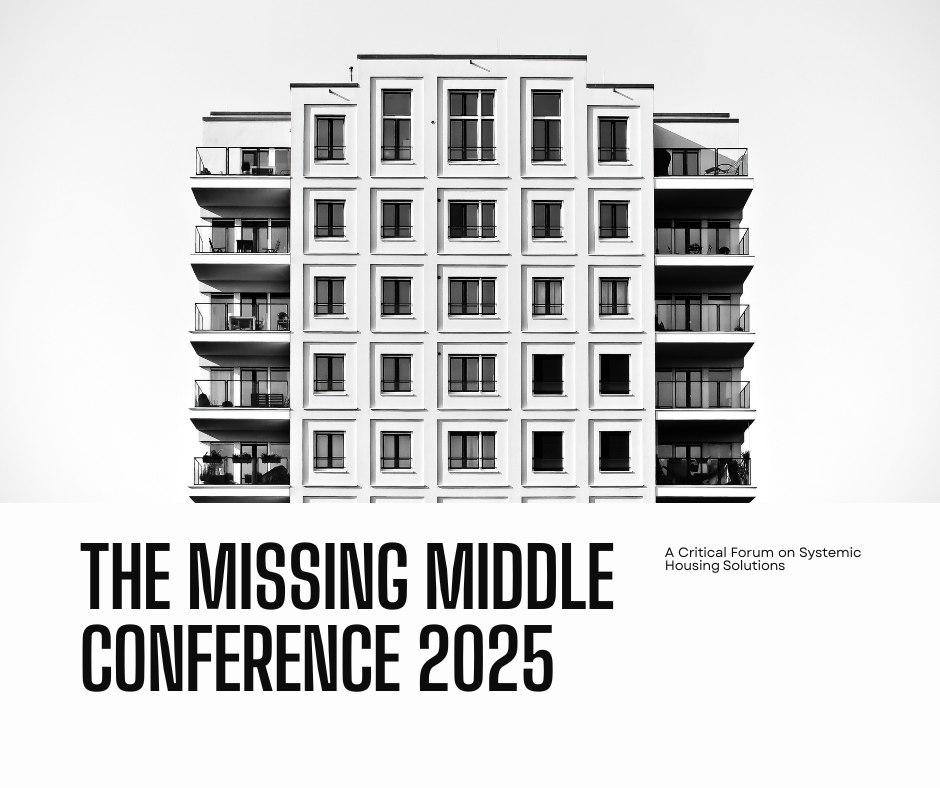The Missing Middle Conference 2025: A Critical Forum on Systemic Housing Solutions
By James Fields, Broker, Trolleybus Realty Inc.
On Friday, September 12, 2025, the Fairmont Royal York in Toronto will host the Missing Middle Conference 2025. This event is positioned as a significant gathering for professionals involved in addressing Canada’s housing supply crisis. The conference is designed to facilitate dialogue among developers, investors, policymakers, lenders, and municipal officials, with a specific focus on the housing typologies that exist between single-detached homes and high-rise towers.
The persistent shortage of housing supply in Canada, particularly in major urban centers like Toronto, has highlighted a critical gap in the market. Development patterns over recent decades have bifurcated mainly into two models: low-density suburban sprawl and high-density urban condominium towers. This has resulted in a scarcity of what is termed the “missing middle”—a range of multi-unit or clustered housing forms that are of a scale compatible with existing residential neighbourhoods.
This analysis will outline the purpose of the conference, define the concept of missing middle housing, detail the systemic barriers to its construction, and explain the conference’s role in addressing these complex challenges.
Defining the “Missing Middle” Housing Typology
The term “missing middle,” coined by architect Daniel Parolek, refers to a spectrum of housing types that are characterized by low to moderate density and a form that is consistent with the scale of single-family homes. These are not new concepts; they are prevalent in the historic neighbourhoods of many Canadian cities. Key typologies include:
Duplexes, Triplexes, and Fourplexes: Multiple dwelling units within a single building that maintains the scale of a large house.
Townhomes and Stacked Townhomes: Attached homes that share side walls, with stacked townhomes featuring units on multiple floors.
Laneway Suites and Garden Suites: Secondary, self-contained residential units located on the same lot as a primary dwelling, typically in a rear yard.
Low-Rise Walk-Up Apartments: Multi-unit buildings, typically under five stories, without elevators.
Live-Work Units: Buildings designed to accommodate both commercial activity and residential living.
The functional purpose of these housing forms is to provide a greater diversity of options within established neighbourhoods. They offer a naturally occurring form of affordability through smaller unit sizes and shared infrastructure, support public transit viability by increasing density gently, and allow for aging in place and socio-economic diversity within communities.
The Systemic Barriers to Missing Middle Development
Despite broad policy recognition of its value, the development of missing middle housing faces significant institutional and economic headwinds. The Missing Middle Conference 2025 is structured to dissect these barriers, which can be categorized as follows:
1. Zoning and Regulatory Restrictions: A substantial portion of residential land in Canadian cities, including Toronto, is zoned exclusively for single-detached homes. While recent policy shifts, such as Ontario’s Bill 23 (More Homes Built Faster Act) and the City of Toronto’s Expanding Housing Options in Neighbourhoods (EHON) initiative, have begun to legalize multiplexes and laneway suites, the regulatory environment remains a patchwork. Setback requirements, height restrictions, floor space index (FSI) limits, and unit maximums often render projects economically unviable even when they are technically permitted.
2. Prolonged and Uncertain Approval Timelines: The development approval process in many municipalities is characterized by complexity and a lack of predictability. Projects that require minor variances or site plan approval can be subject to months or years of review, community consultation, and potential appeals. This timeline uncertainty adds significant carrying costs (e.g., land financing, taxes, professional fees) to projects that already operate on thin margins. For smaller-scale missing middle projects, these costs can be prohibitive.
3. Misaligned Financing Models: The financial industry is structured around two primary models: single-family residential mortgages and large-scale commercial construction loans. Missing middle projects often fall into a gap, being too complex for a standard mortgage yet too small for the commercial lending division of major banks. Lenders frequently perceive these projects as higher risk due to their novelty, smaller loan sizes, and the developer’s potentially limited track record. This creates a financing chasm that stifles development.
4. Economic Feasibility Challenges: The economics of missing middle development are frequently strained by high fixed costs that are not scaled to the project’s size. Key among these are:
Development Charges (DCs): These per-unit fees, intended to pay for municipal infrastructure growth, are often the same for a fourplex as for a 40-unit condo, creating a disproportionate burden on smaller projects.
Parkland Dedication Fees: Similarly, these costs can render a small infill project financially unworkable.
Construction Costs: Achieving economies of scale is difficult with projects involving 10-50 units. Traditional construction methods may be less cost-effective at this scale.
5. Community Opposition and Political Dynamics: Proposals for missing middle housing often face opposition from existing residents, a phenomenon commonly referred to as NIMBYism (“Not In My Backyard”). Concerns typically revolve around fears of increased traffic, parking congestion, loss of neighbourhood character, and shadows. This opposition can translate into political pressure on municipal councils, leading to the rejection of projects or the imposition of conditions that further undermine their viability.
The Conference Agenda: A Factual Breakdown of Sessions
The Missing Middle Conference 2025 is organized into sessions that correspond directly to the identified barriers. The goal is to move from identifying problems to discussing concrete solutions.
Session 1: Policy Frameworks and Zoning Reform. This session will feature municipal planners and policymakers discussing the implementation of provincial legislation and local initiatives like EHON. The focus will be on the practical application of “as-of-right” zoning and the remaining regulatory hurdles.
Session 2: Navigating the Approval Process. Development consultants, lawyers, and municipal officials will provide insights into streamlining approvals, reducing timeline uncertainty, and creating clear guidelines for developers.
Session 3: Financing and Pro Forma Analysis. This session brings together lenders from institutions like CMHC, credit unions, and private equity firms to discuss financial products tailored to missing middle development. It will include a factual breakdown of pro formas, examining how specific costs (DCs, construction, soft costs) impact project viability.
Session 4: Construction Innovation for Mid-Scale Projects. Builders and architects will present on cost-saving construction methods, such as prefabrication, panelized systems, and mass timber, which can improve efficiency and predictability for low-rise multi-unit projects.
Session 5: Engaging Communities and Managing Stakeholder Expectations. This panel will feature urban planners, communications specialists, and municipal councillors discussing evidence-based strategies for community engagement, dispelling misinformation, and building consensus around gentle density.
The Role of Key Stakeholders and Speakers
The conference brings together a cross-section of experts necessary for a holistic discussion. Their participation indicates the issue’s recognition at multiple levels of government and industry.
Policymakers (e.g., Mayor Olivia Chow, Mayors from Burlington, Barrie, and Newmarket): Their presence signifies the municipal recognition of the problem and a willingness to engage with the development community on solutions.
Economists and Data Analysts (e.g., Mathieu Laberge of CMHC, Peter Norman of Altus Group): These speakers provide the empirical foundation, offering data on housing supply gaps, rental market dynamics, and the economic impact of regulatory barriers.
Private Sector Practitioners (e.g., Developers, Brokers, Planners, Lenders): These individuals operate within the constraints of the current system. Their contributions are grounded in the practical realities of acquiring land, securing financing, navigating regulations, and constructing buildings profitably.
The value of the conference lies in the intersection of these perspectives, creating a forum for evidence-based dialogue between the public sector that sets the rules and the private sector that operates within them.
Case Studies: Lessons from Other Jurisdictions
The conference is expected to examine precedents from other North American cities that have implemented reforms to encourage missing middle housing. These provide a factual basis for assessing potential policies in Ontario.
Minneapolis, Minnesota, USA: In 2018, the city passed its Minneapolis 2040 plan, which eliminated single-family exclusive zoning city-wide, allowing triplexes on all residential lots. The city also eliminated mandatory parking minimums for new developments. Early studies indicate a modest but positive increase in housing supply and a slowing of rent growth in areas with new density.
Portland, Oregon, USA: Portland’s Residential Infill Project allowed up to four units on any lot (six if affordable units are included) and removed parking mandates. The policy was designed to increase housing choice and affordability by right.
Auckland, New Zealand: In 2016, Auckland’s Unitary Plan upzoned roughly three-quarters of its residential land, allowing for more density. Extensive economic research has attributed a significant increase in housing supply and a moderation of housing price growth to these planning reforms.
Kitchener, Ontario, Canada: The City of Kitchener has been proactive in reducing barriers, including reducing parking requirements and development charges for certain types of infill development, providing a relevant Canadian case study.
Analyzing the outcomes, both intended and unintended, of these policies provides valuable data for informing similar efforts in the Greater Toronto Area.
Conclusion: The Conference as a Node in a Larger Process
The Missing Middle Conference 2025 is not presented as a singular solution to Canada’s housing crisis. It is more accurately understood as a critical node in a complex, ongoing process of market correction and policy adaptation.
The value of such a gathering is multifactorial:
Information Dissemination: It consolidates and disseminates current information on regulatory changes, financial models, and construction techniques.
Network Formation: It facilitates connections between developers, financiers, and policymakers, which can lower transaction costs and foster collaboration.
Problem-Solving: It provides a structured environment for identifying persistent obstacles and workshopping potential solutions.
The development of missing middle housing is a demonstrably necessary component of a comprehensive housing strategy. Its advancement requires the alignment of zoning policy, financial instruments, construction innovation, and community engagement. The conference serves as a dedicated forum for professionals across these disciplines to engage in the detailed, factual, and practical work required to make this housing form a scalable reality. The success of such efforts will be measured by the subsequent increase in the construction of diverse, ground-oriented housing forms within Toronto’s established neighbourhoods and across Canada.
James Fields Broker Trolleybus Realty Inc. Brokerage


